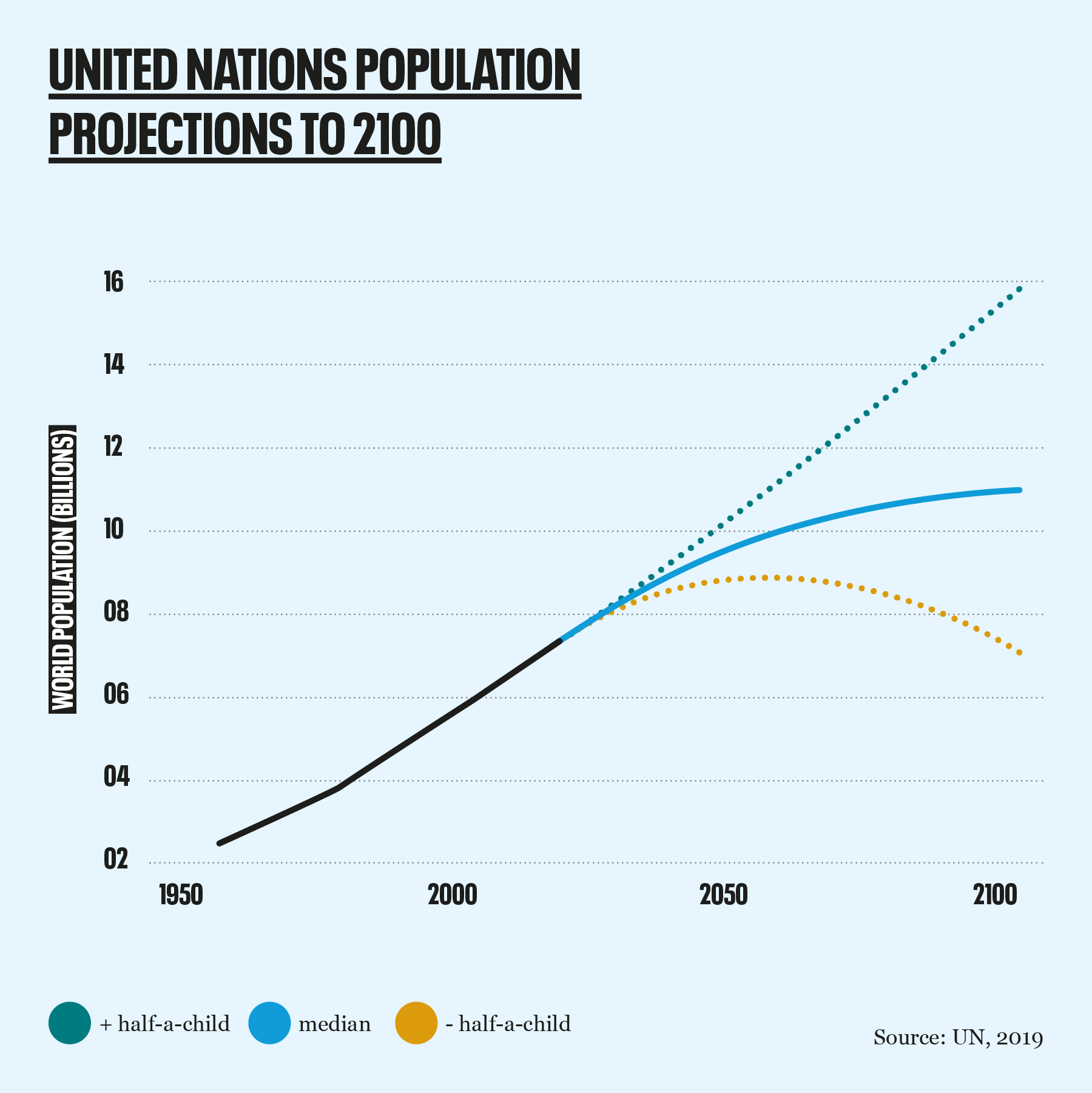
UN report: Small change in family size, big change in future population
According to new UN data, the world’s population is projected to grow by more than 3 billion people by the end of the century, increasing from the current 7.7 bn to 10.9 bn. As in previous years, the data show that small changes in family size translate into a difference of several billion people by the end of the century – just half a child less per couple would see our population peak well before 2100 before declining to 7.3 bn.
The United Nations Department of Economic and Social Affairs (UNDESA) today released its latest World Population Prospects report which includes growth projections up to 2100. The revised figures are slightly lower than the ones released in the last report published in 2017. This is a welcome development as previous projections have usually been revised upwards.

KEY POINTS
- The new median projection estimates a global population of 9.7 billion people in 2050 and 10.9 billion by 2100, whereas 2017 estimates were 9.8 bn and 11.2 billion, respectively.
The median or “medium variant” projection assumes global fertility will fall from just under 2.5 births per woman in 2019 to around 2.2 in 2050 and further to 1.9 in 2100.
- If every other family had one fewer child than the median projection, there would be 8.9 bn by 2050 and our population would decline to 7.3 bn people by 2100 – a smaller population than today.
- Conversely, if every other family had one child more than the median projection, there would be 10.6 bn by 2050 and as many as 15.6 bn by 2100.
- The fastest growth is occurring in sub-Saharan Africa, where the population is expected to double by 2050. Europe and Northern America will see the smallest proportional increase (2%).
- Nine countries will make up over half the projected total increase by 2050: India, Nigeria, Pakistan, the Democratic Republic of the Congo, Ethiopia, Tanzania, Indonesia, Egypt and USA.
- Around 2027, India is expected to overtake China as the world’s most populous country.
- The global fertility rate (the average number of children per woman) is continuing to decrease, with almost half of all people living in a country or area where the number of children born per woman is below 2.1, the ‘replacement rate’.
Replacement rate: the average number of children needed per woman to achieve a stable population (no increase or decrease). The figure is slightly higher than 2 to account for infant and child mortality.
- In several developing regions, declining fertility rate has led to a proportionally greater working age cohort, helping to boost economic growth.
- Despite progress, many countries are still struggling with high fertility rates and sub-Saharan Africa is disproportionately affected, with an average of 4.6 children per woman.
- Rapid population growth and its causes continue to pose a major impediment to achieving the Sustainable Development Goals, in particular eradicating hunger and poverty, achieving gender equality, and improving health and education.
- 55 countries are projected to experience a population reduction by 2050. China’s population, for example, is projected to decrease by 2.2% or 31.4 million.
- In 2018, for the first time in history, there were more people aged 65 or above than children under five. The global population will continue to age as an inevitable side effect of decreasing fertility. Governments need to prepare for the economic and social challenges this may bring.


Population Matters comment:
These figures represent the good, the bad and the ugly. The good: declining fertility and increasing longevity, reflecting improved quality of life for most of us, and at least the distant prospect of a flattening of population growth. The bad: astronomical population growth in the regions least able to cope, and the challenges of supporting a greater proportion of old people. And the ugly: billions more people putting intense pressure on a finite Earth, which already has overexploited natural resources, vanishing biodiversity and a dangerously warming climate. Our numbers and impact on the planet are already too great, and billions more people to consume, make greenhouse gases and pollute threaten to undo all the good we can do in terms of reducing our impact in other ways.
It’s very welcome to see a slight downward adjustment in population projections but these figures nail the myth that population is going to decline soon – there’s only a one-in-four chance of that happening by the end of the century. Even these small gains are under threat. Family planning programmes in the world’s poorest countries are failing to meet their targets, while religious and political ideologues oppose birth control and choice over abortion, and promote pro-natal policies that threaten to undo the progress we’ve made.
We must end our addiction to unsustainable growth. Ageing populations are a challenge, but far from an insuperable one if we devote the resources necessary. Environmental catastrophe is a looming, credible and existential threat that requires us to take every ethical, practical measure at our disposal to ensure we have a habitable planet. If we don’t, nature could make its own intervention and our numbers could crash through the worst of all possible means.
These projections do offer hope: small changes in family size translate into a difference of several billion people by the end of the century – just half a child less per couple would see our population peak well before 2100 before declining to 7.3 bn. We have the time (just) and means to manage our population humanely and ethically such that future generations can live in balance and harmony with the natural world and the ecosystems upon which our wellbeing depends. That means family planning, education, women’s empowerment, ending poverty and promoting small families. Where people don’t have the choice to have a smaller family, they must have it – where they do have the choice, it’s vital they exercise it –especially in rich, high consuming countries where our environmental impact is so great. These projections represent too little progress, and without the right actions now, it will be too late to change them. That’s why the world needs an international policy framework on the overriding, upstream factor of population, as there is for the downstream issue of climate change.
